The Fordham Museum of Greek, Etruscan, and Roman Art Reopens on March 6th
By Hannah Herrlich, Emerging Technologies Librarian
The antiquities in the Fordham Museum of Greek, Etruscan, and Roman Art were donated to the university by William D. Walsh, an alumnus of FCRH, and his wife, Jane. The museum opened in December 2007, and with its collection of more than 260 objects, was swiftly incorporated into multiple curricula, demonstrating that 2,500-year old works of art were able to provide a lens into ancient history with a contemporary focus.
However, since June 1st 2021, the Fordham Museum has been closed to the university community. On that day approximately 99 objects in the collection were seized by the Manhattan District Attorney’s (D.A.) Office as evidence in an ongoing criminal investigation and Grand Jury trial being brought against a trafficker in ancient art. While Fordham was neither the target of the D.A.’s case nor believed to be complicit in any way, the material seized still passed through the hands of the subject of the investigation. What this means is that although William Walsh, who donated his collection to Fordham in 2006, acted in good faith when he acquired the objects on the market, they actually belong to Italy.
The remaining pieces left behind from the investigation were de-installed and placed in storage. During its closure, the museum underwent renovations and will now reopen to the public beginning on Monday, March 6th, 2023.
We chatted with Dr. Jennifer Udell, curator of the Fordham Museum of Greek, Etruscan and Roman Art about its reopening!

We can’t wait to have the museum open again! What are you most looking forward to in having the museum open again?
I’m really looking forward to getting my classes back in the museum space and studying the artifacts in-person again. There is so much to learn by observing the physicality of these works that extends beyond sharing a digital image in a classroom. Art history has just as many unknowns as the sciences. Just as in Fordham science labs, art history scholars conduct research in the arts; in this case, the lab is the museum and its collection. I try to teach students to employ the same research techniques used at any major museum. And, in general, it will be exciting to have the museum reemerge as an integral service and space of Walsh Library. In the past, new users would come to the library and be stunned that such a place exists right on the Atrium floor.
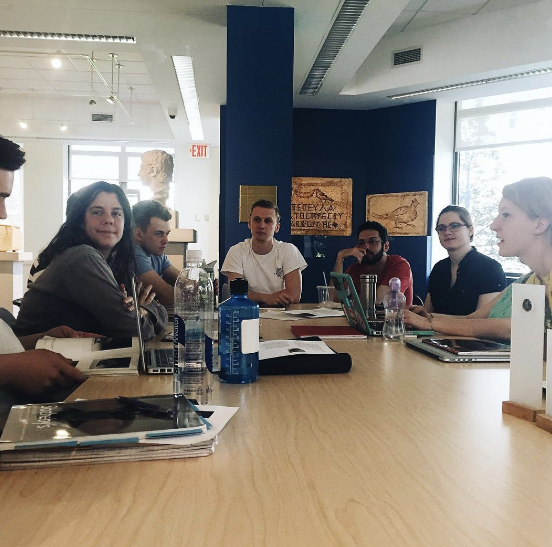
Walk us through the process of packing up the seized objects and shipping them to Italy. Undoubtedly, these are fragile items!
Have you ever moved homes? Well, it was like that– only more so. As you mentioned, these are delicate artifacts that had to be shipped to another continent so ensuring that everything was packaged carefully was a daunting task. We had some outside assistance from professional packers, but still, moving is never easy. Fortunately, all of the items made it back to Italy in one piece. And of course, the facilities team who helped renovate the museum space while the items were in transit did a fantastic job on bringing my vision of the new museum to life.
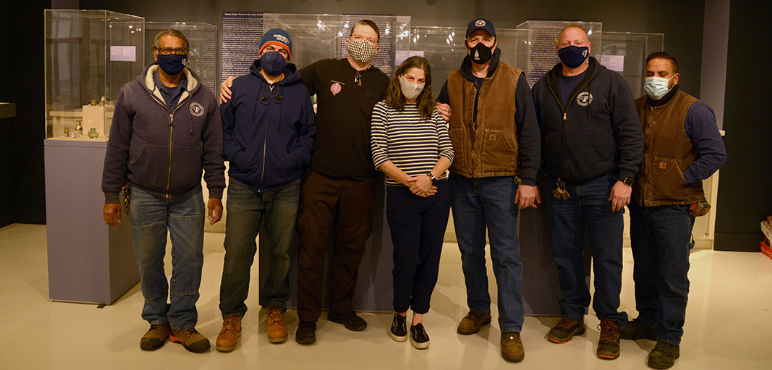
If you could choose one item from the museum to bring with you to the beach, what would it be and why?
Well, let’s see, a proper beach day must include a totally awesome drinking cup, right? I think the chalice with lotus buds and pomegranates would be perfect. Can you imagine sipping wine, water, beer, a banana smoothie (whatever your drink of choice is) out of that thing? You’d easily be the coolest person on the beach! Now, if I wanted to upgrade my beach drinking experience to something somewhat ridiculous, I’d reach for the askos (flask) with Nike figurines and Medusa heads in relief. It might not be the most practical option, but how many other people on the beach are going to have a Canosan pottery flask with Medusa’s head in the center? Lastly, if I was feeling particularly school-spirited, I’d opt for the ram’s head drinking cup. Now that would be a cool way of representing Fordham.
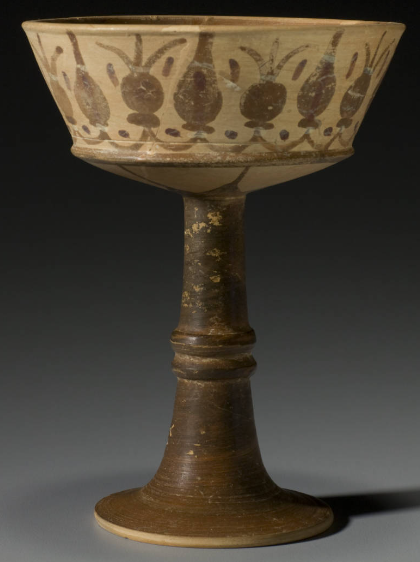
Label text: Pontic ware is a complicated misnomer for a class of vases probably made in southern Etruria grouped according to style. The name derives from the subject of an amphora in the Vatican depicting Scythian (Pontic-Black Sea) archers on horseback.
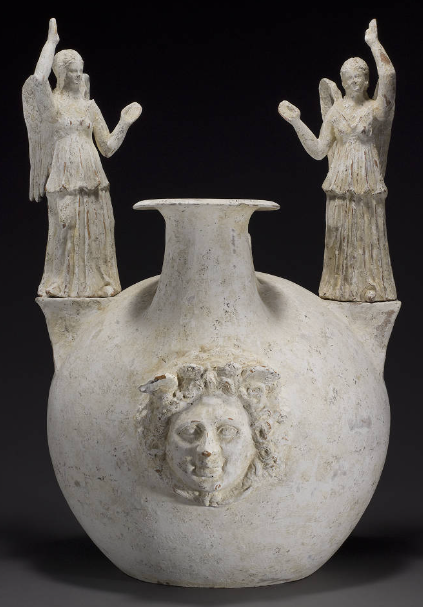
Label text: This large askos is typical of Canosan pottery. It combines polychrome decoration, much of which has faded leaving behind only the white ground, and coroplastic (terracotta) additions, consisting of groups of figures in the round and appliques of relief heads. Canosan pottery derives its name from the tomb complex at Canosa, where most examples of this type of vase were excavated, but its exact center of production is still unknown. The predominant view is that these vases were made along the Adriatic coast, in the artistic centers of either Daunia of Messapia, as both were cultural crossroads that may explain the Egyptian-Alexandrian style of clothing worn by the Nike figurines.
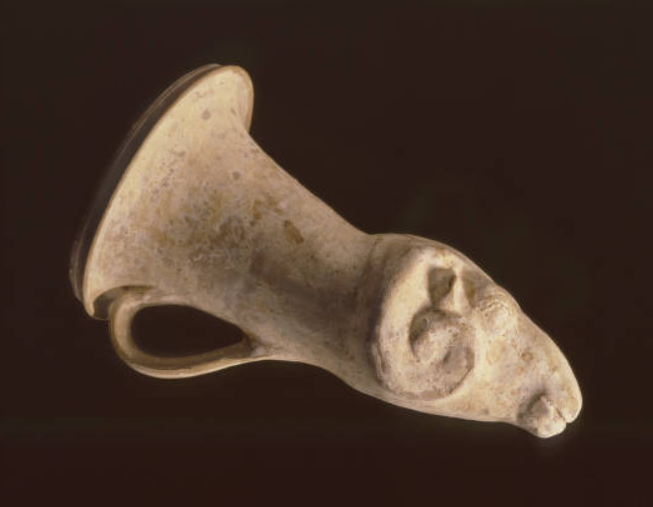
Lastly and most importantly, as a huge fan of The Rolling Stones, what do you think Mick Jagger’s favorite item in the museum would be?
Haha! Given that Mick is the ultimate rock star, I can see him donning the twenty-two necklace pendants and ornaments– he would look so glamorous! Another item that comes to mind is the incense burner in the shape of a woman’s head. I don’t know why, but I feel if Mick were to burn incense, he would do so out of that Hellenistic beauty.
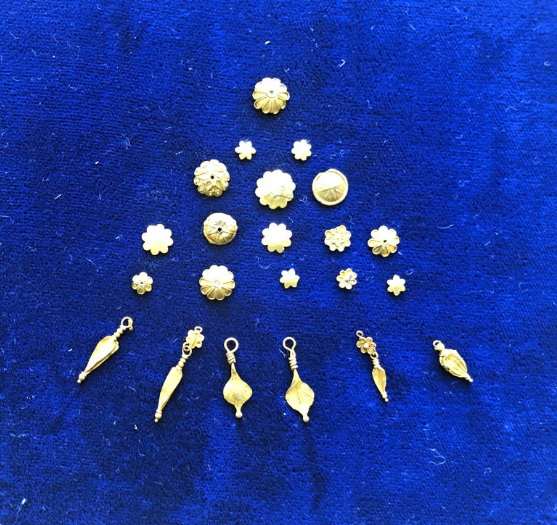
Label text: The motifs employed by ancient goldsmiths were numerous. Among the most common are: disks with Macedonian shields (top row, left); multilevel rosettes (bottom row, right); leaf-shaped ornaments; and beech nut pendants (both, bottom row, left). The beech tree was ubiquitous in northern Greece, particularly Macedonia, where it is thought that the beech nut pendant motif in jewelry may have originated.
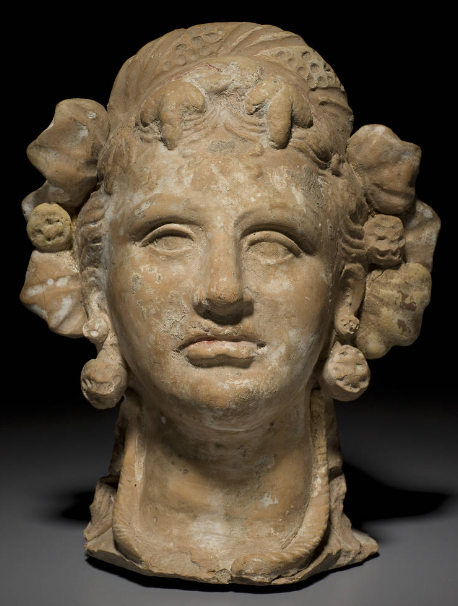
Label text: Canosan incense burners of this type were often surmounted by a crown of calyx leaves which held a small burning bowl. A circular area of unglazed clay at the top of the woman’s head suggests that this example was originally made to hold a receptacle in which the incense was burned. This object, like the other examples of Canosan pottery displayed in this case, was once vibrantly painted over a ground of white slip. Only traces of the polychromy remain visible.
The Fordham Museum of Greek, Etruscan, and Roman Art is located in the Atrium of the Walsh Library. The museum will be accessible to all patrons and visitors beginning on March 6th, 2023. For more information about the museum, visit our research guide.


